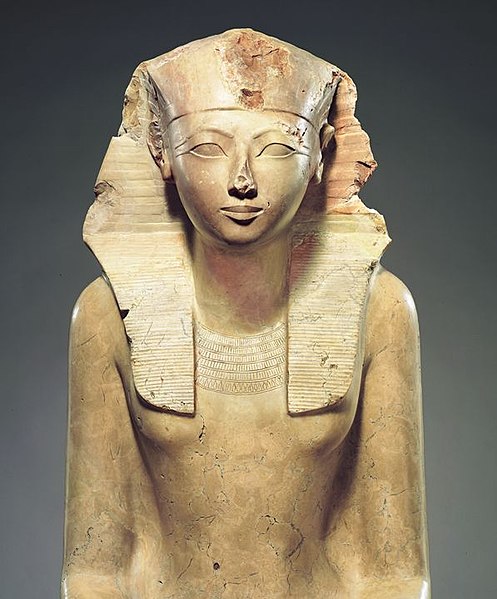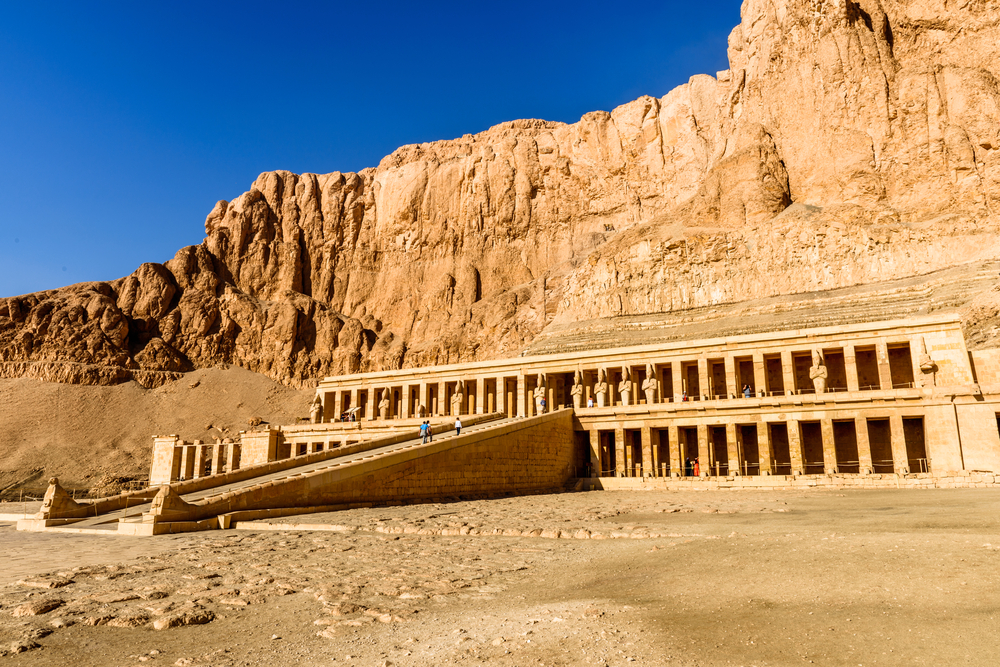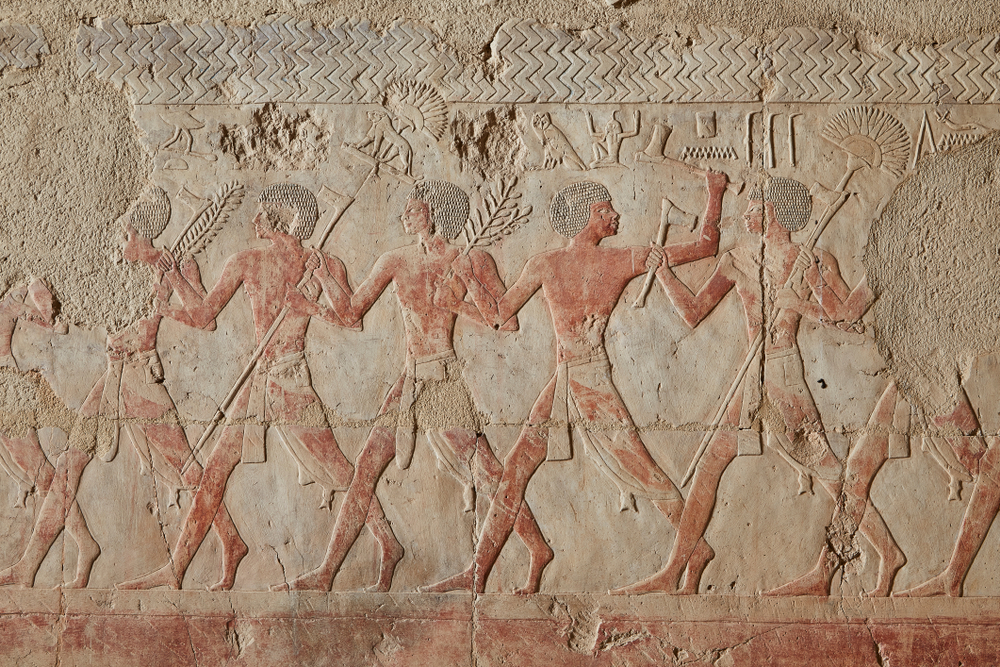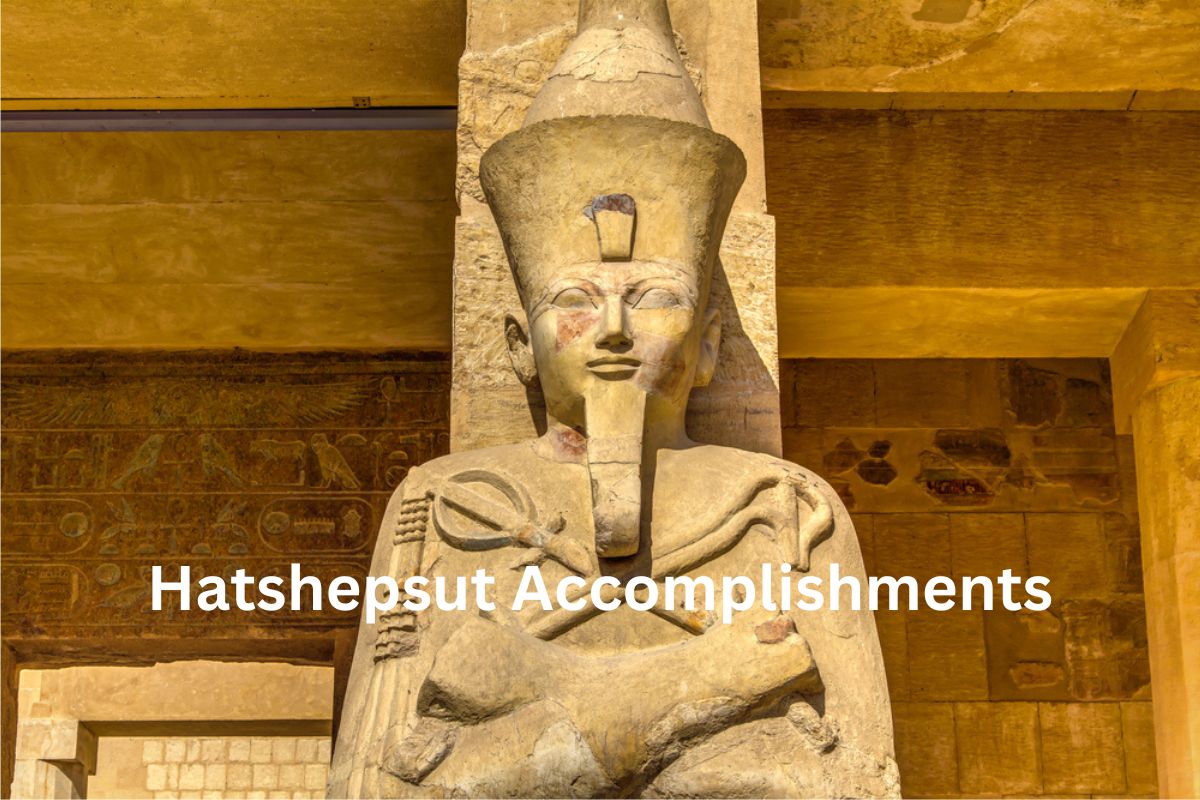Hatshepsut’s career as pharaoh was marked by remarkable accomplishments and influence. She ascended to the throne as a regent for her stepson, but gradually consolidated her power and became the ruling monarch.
Hatshepsut, born in 1507 BCE, was an ancient Egyptian pharaoh and one of the most influential female rulers in history. She was the daughter of Pharaoh Thutmose I and Queen Ahmose, and she married her half-brother Thutmose II.
After Thutmose II’s death, Hatshepsut served as regent for her stepson Thutmose III, but she eventually took on the title of pharaoh and became the ruling monarch.
During her reign, she focused on economic growth through trade expeditions to the land of Punt and initiated ambitious building projects, including her renowned mortuary temple, Deir el-Bahari.
She also restored neglected religious sites, supported artistic and cultural development, and left a lasting legacy.
Accomplishments of Hatshepsut
1. First female pharaoh in ancient Egypt
Hatshepsut’s most notable accomplishment was breaking gender barriers and becoming the first female pharaoh in ancient Egypt. By assuming the throne, she challenged the traditionally male-dominated role of pharaoh, establishing herself as a powerful ruler and paving the way for future female leaders.
2. Expanded trade networks and brought wealth to Egypt
Hatshepsut recognized the importance of trade for the prosperity of Egypt. During her reign, she actively expanded Egypt’s trade networks by organizing and leading multiple trade expeditions.

The most famous of these expeditions was to the land of Punt, an exotic region rich in valuable resources. These expeditions brought back coveted goods like incense, gold, ebony, and rare animals, enhancing Egypt’s wealth and prestige.
3. Led successful trade expeditions to the land of Punt
One of Hatshepsut’s most significant accomplishments was her successful trade expeditions to the land of Punt. The precise location of Punt remains uncertain, but it is believed to have been located in present-day Eritrea, Somalia, or Sudan.
The expeditions were conducted via both land and sea routes, showcasing Hatshepsut’s strategic planning and organizational skills. The trade missions to Punt brought back abundant riches, exotic goods, and valuable resources that contributed to the economic growth and cultural influence of Egypt.
These expeditions were celebrated as a testament to Hatshepsut’s prowess as a leader and her ability to establish diplomatic and economic relations with foreign lands.
4. Built impressive monuments and temples, including Deir el-Bahari
Hatshepsut was renowned for her ambitious architectural projects. She commissioned the construction of several grand monuments and temples throughout Egypt, the most notable being her mortuary temple at Deir el-Bahari in Thebes.

The temple was an architectural marvel, featuring a series of terraces, colonnades, and courtyards. The walls of the temple were adorned with intricate reliefs depicting scenes from Hatshepsut’s life and her divine birth.
The construction of these magnificent structures showcased her power and perpetuated her memory for generations to come.
5. Restored neglected religious sites and promoted religious practices
Hatshepsut held a deep reverence for the gods and sought to restore the neglected religious sites of Egypt. She dedicated resources to renovating and revitalizing temples and shrines that had fallen into disrepair.
Through these efforts, she aimed to strengthen the religious practices and institutions of Egypt. Hatshepsut also actively participated in religious rituals and ceremonies, portraying herself as a pious ruler and demonstrating her devotion to the gods.
6. Introduced innovative artistic and architectural styles
Hatshepsut’s reign marked a period of artistic and architectural innovation in ancient Egypt. She encouraged the use of new artistic styles and techniques in temple decorations.
One notable example is the portrayal of Hatshepsut herself in male pharaoh’s clothing, emphasizing her authority and legitimacy. The reliefs and wall paintings in her temples showcased detailed and vibrant scenes from daily life, religious rituals, and the royal court.
Hatshepsut’s patronage of the arts brought forth a fresh aesthetic that departed from traditional conventions, leaving a lasting impact on Egyptian artistic expression.
7. Left behind detailed inscriptions documenting her reign
Queen Hatshepsut was keen on preserving her legacy and ensuring that her accomplishments were remembered. She commissioned inscriptions and reliefs on the walls of her mortuary temple and other structures, which detailed her reign, achievements, and policies.

These inscriptions provided valuable historical records that allowed future generations to learn about her reign and understand her significance in Egyptian history.
8. Initiated mining expeditions to acquire valuable resources
Hatshepsut recognized the importance of natural resources for Egypt’s economy and power. She actively organized mining expeditions to extract valuable resources such as gold, copper, and precious stones.
These expeditions were conducted both within Egypt’s borders and in neighboring regions. By acquiring these resources, Hatshepsut bolstered Egypt’s wealth and influence while ensuring a steady supply of essential materials for crafts, trade, and construction.
9. Implemented agricultural development projects
Recognizing the significance of agriculture for sustaining Egypt’s population, Hatshepsut implemented projects to enhance agricultural productivity. She undertook irrigation projects to improve water management and expand the cultivable land.
Additionally, she initiated land reclamation efforts to bring more fertile areas under cultivation. These agricultural developments aimed to ensure food security and provide for the growing population of Egypt during her reign.
10. Established a lasting legacy through monuments and statues
Queen Hatshepsut sought to establish a lasting legacy for herself and ensure that she would be remembered in the annals of Egyptian history. She commissioned the construction of numerous statues and monuments depicting her image and achievements.
These statues and monuments were strategically placed in temples and other public spaces to perpetuate her memory and emphasize her role as a great ruler. By leaving behind these enduring symbols of her reign, Hatshepsut ensured her place in history as one of the most influential pharaohs of ancient Egypt.
